
The Solar-Terrestrial Centre of Excellence (STCE) is a collaborative network of the Belgian Institute for Space Aeronomy, the Royal Observatory of Belgium and the Royal Meteorological Institute of Belgium.
 |
Published by the STCE - this issue : 28 Aug 2015. The Solar-Terrestrial Centre of Excellence (STCE) is a collaborative network of the Belgian Institute for Space Aeronomy, the Royal Observatory of Belgium and the Royal Meteorological Institute of Belgium. |
| Archive of the newsletters | Subscribe to this newsletter by mail |
Solar flare activity fluctuated between very low and moderate during the week.
In order to view the activity of this week in more detail, we suggest to go to the following website from which all the daily (normal and difference) movies can be accessed:
http://proba2.oma.be/ssa
This page also lists the recorded flaring events.
A weekly overview movie can be found here (SWAP week 282).
http://proba2.oma.be/swap/data/mpg/movies/weekly_movies/weekly_movie_2015_08_17.mp4
Details about some of this week's events, can be found further below.
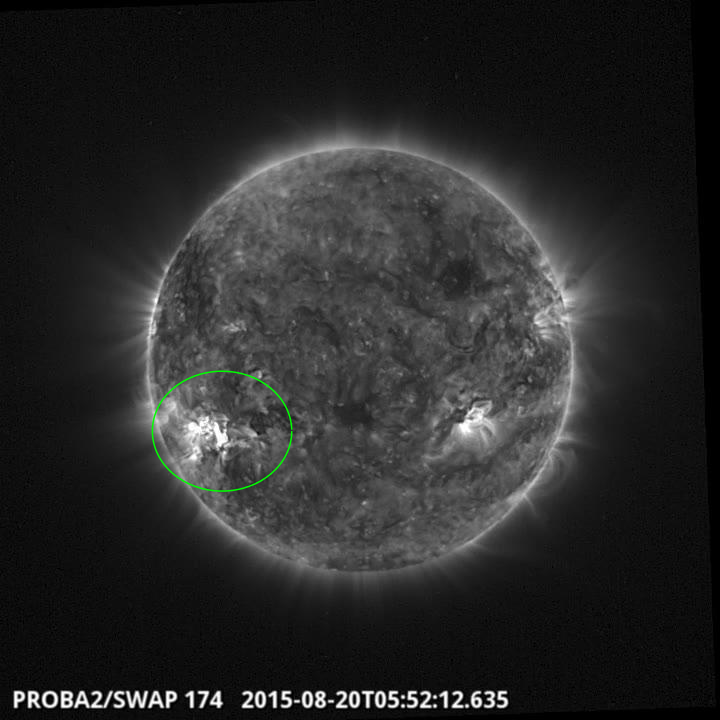
Mflare and dimming in the south east @ 05:52 UT SWAP image
Find a movie of the event here (SWAP movie)
http://proba2.oma.be/swap/data/mpg/movies/20150820_swap_movie.mp4
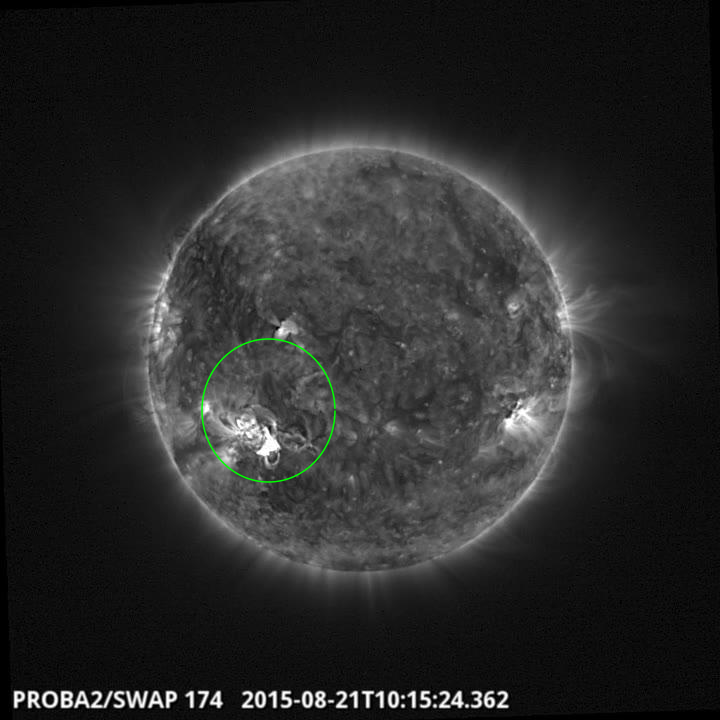
Mflare in the southeast @ 10:15 UT SWAP image
Find a movie of the event here (SWAP movie)
http://proba2.oma.be/swap/data/mpg/movies/20150821_swap_movie.mp4
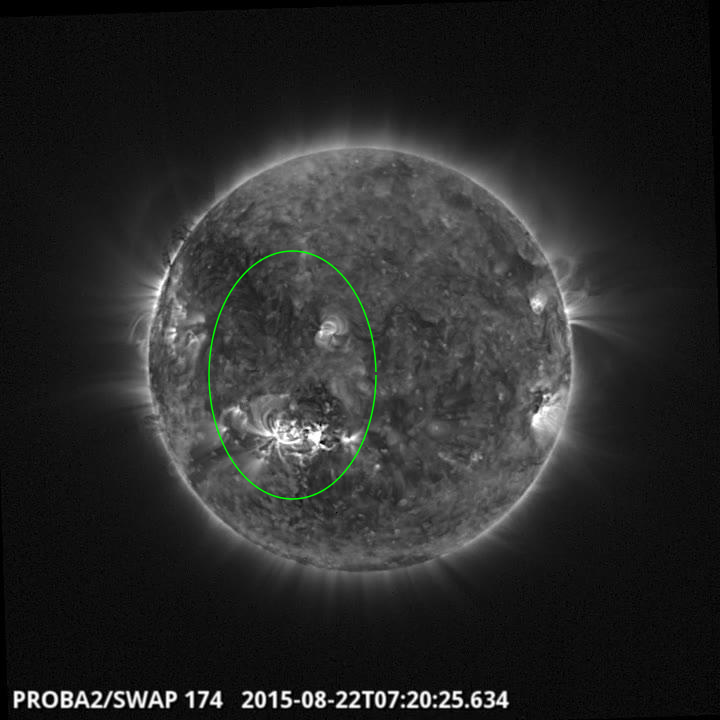
Mflare and wave in the south east @ 07:20 UT SWAP image
Find a movie of the event here (SWAP movie)
http://proba2.oma.be/swap/data/mpg/movies/20150822_swap_movie.mp4
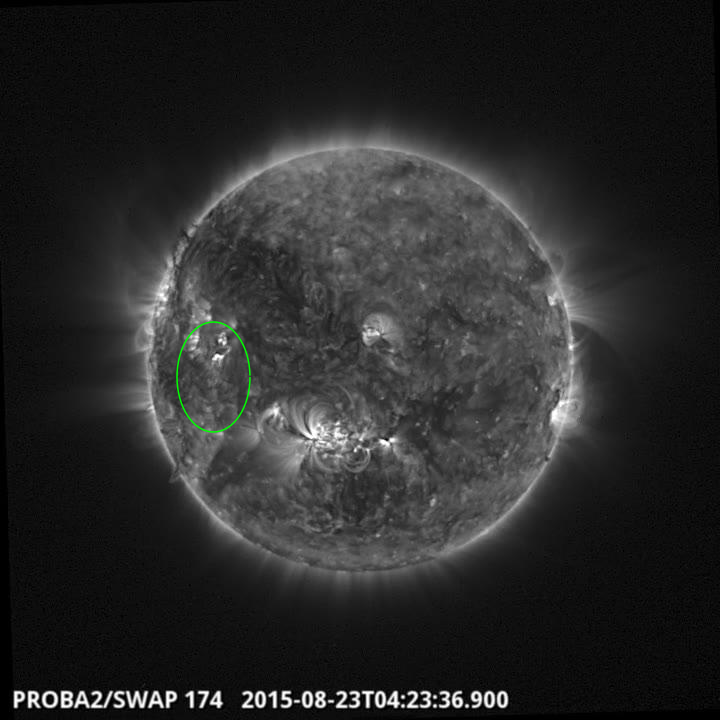
Filament eruption in the east @ 04:23 UT SWAP image
Find a movie of the event here (SWAP movie)
http://proba2.oma.be/swap/data/mpg/movies/20150823_swap_movie.mp4
Solar activity varied dramatically over the course of the week.
From Aug 17 to 19 solar activity was low, with no solar flares above the B-class level and no CMEs. However, there was one coronal hole that increased geomagnetic activity to K-index values of 5. There was a small filament destabilisation and eruption at 17:00 UT on Aug 19 close to the south east limb of the Sun. It was not Earth directed.
Once AR 2403 rotated over the east limb on Aug 18, it started to show significant growth and flux emergence mid-week. The region evolved from a Macintosh:Dac/Type:Beta to Macintosh:Dkc/Type:Beta-Gamma and finally to a Macintosh:Ekc/Type:Beta-Gamma-Delta region by the end of the week. In the series of images taken by SDO/HMI you can follow its growth.
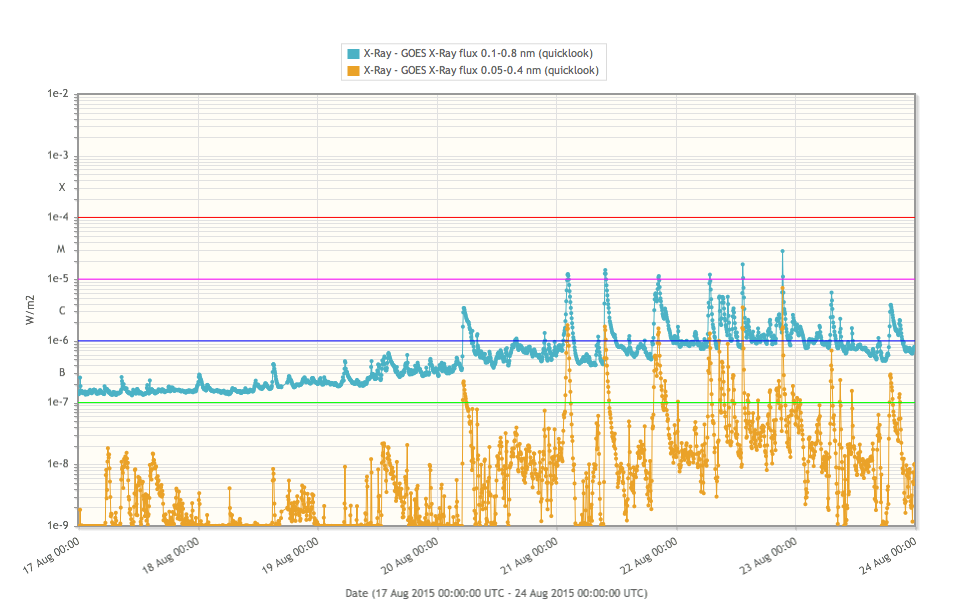
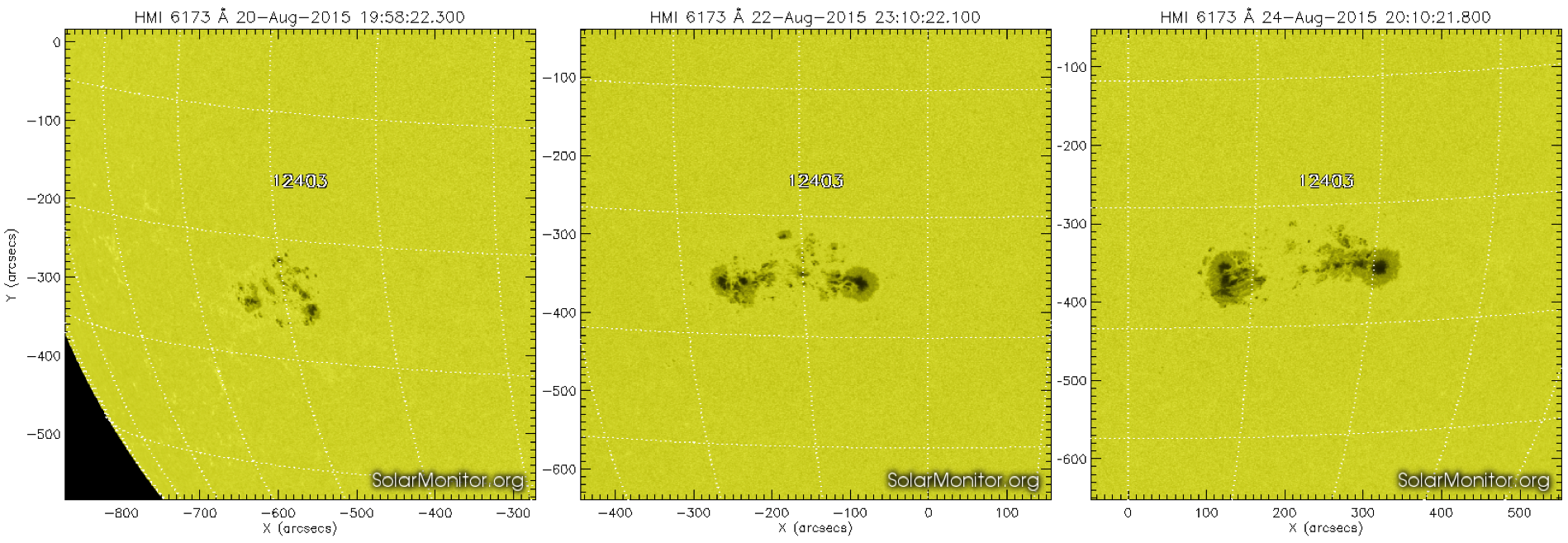
Several of the flares exhibited associated coronal dimmings observed in the AIA 193 Å bandpass, indicating the presence of an associated CME. However, only two partially Earth directed CMEs were noted.
Firstly a CME associated with the M1.4 flare on Aug 21, 09:48 UT. At that time, the AR was located at S17E26, and the CME was largely directed to the south east. The CME had a speed of around 300 km/s according to CACTus.
Secondly, a very faint halo CME, first observed in LASCO imagery at 07:12 UT, Aug 22 associated with the M1.2 flare. Although it is difficult to estimate the speed with which the CME is travelling toward the Earth in the absence of STEREO data, it is estimated to be roughly around 650 km/s.
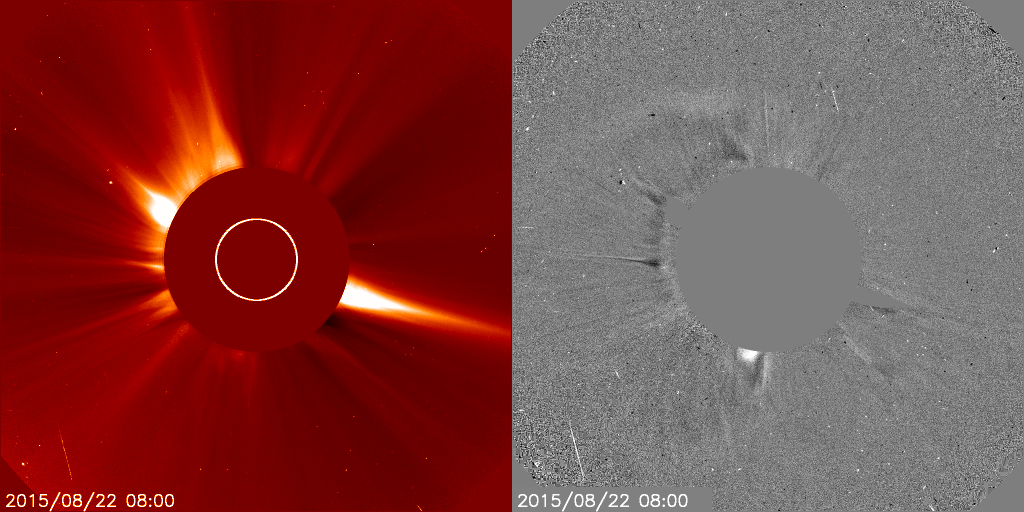
A link between this CME and the passage of a magnetic structure with a slowly rotation magnetic field is possible. The magnetic structure was not preceded by a shock. More next week, but we give you already an ACE preview.
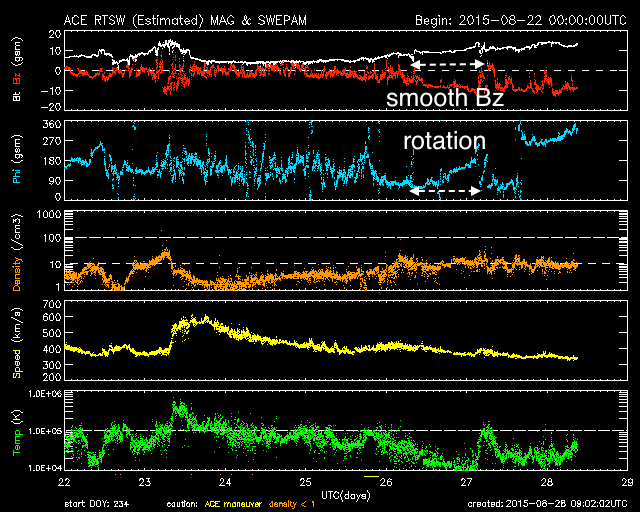
Throughout the week other ARs remained quiet and did not produce any flares above the B-class level. Proton activity remained quiet.
| DAY | BEGIN | MAX | END | LOC | XRAY | OP | 10CM | TYPE | Cat | NOAA |
| 21 | 0156 | 0218 | 0237 | S16E39 | M1.2 | 1F | 2403 | |||
| 21 | 0934 | 0948 | 1007 | S17E26 | M1.4 | 2B | 73 | II/1 | 2403 | |
| 21 | 1910 | 2034 | 2050 | S12E26 | M1.1 | 1N | III/1 | 2403 | ||
| 22 | 0639 | 0649 | 0659 | S15E20 | M1.2 | 1B | 62 | II/2IV/2 | 2403 | |
| 22 | 1317 | 1323 | 1329 | S15E19 | M2.2 | 1N | 2403 | |||
| 22 | 2119 | 2124 | 2128 | S15E15 | M3.5 | 1B | 2403 |
| LOC: approximate heliographic location | TYPE: radio burst type |
| XRAY: X-ray flare class | Cat: Catania sunspot group number |
| OP: optical flare class | NOAA: NOAA active region number |
| 10CM: peak 10 cm radio flux |

Daily Estimated International Sunspot Number (EISN, red curve with shaded error) derived by a simplified method from real-time data from the worldwide SILSO network. It extends the official Sunspot Number from the full processing of the preceding month (green line). The plot shows the last 30 days (~ one solar rotation). The horizontal blue line shows the current monthly average, while the green dots give the number of stations included in the calculation of the EISN for each day.
For the majority of the week the solar wind speed varied between 400 and 600 km/s, the total interplanetary magnetic field (IMF) strength remained largely between 8 and 10 nT and the Bz component varied between +8 and -8 nT. The presence of two small coronal holes that rotated toward the western limb induced quiet to active geomagnetic conditions throughout the week.
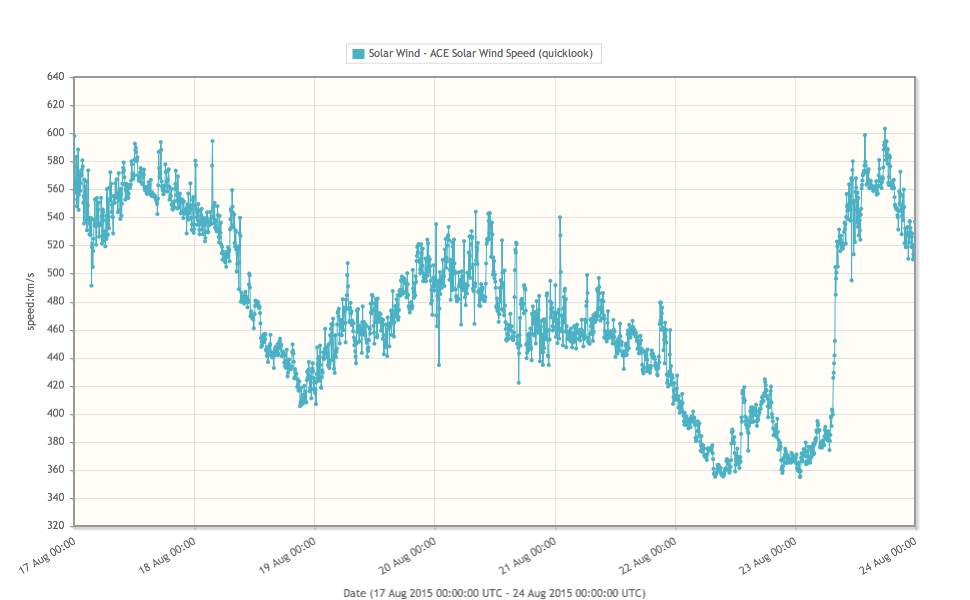
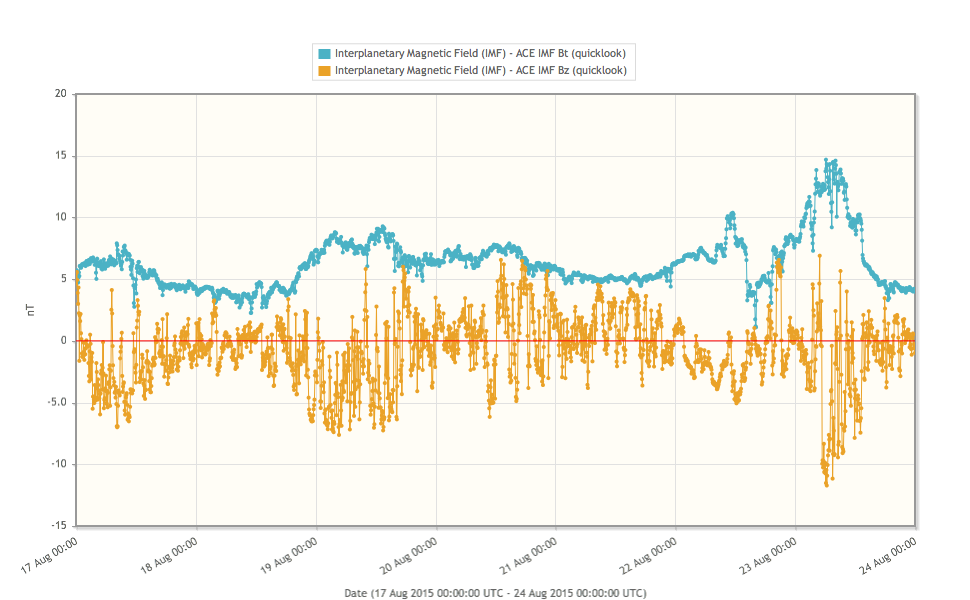
Both the Local (Dourbes) and NOAA Kp-index varied between 3 and 4 throughout the week. NOAA Kp reached 5 around 15:00 UT on Aug 17, these conditions were probably caused by a high speed stream created by a geoeffective coronal hole combined with a southward Bz.
Aug 23 the solar wind speed abruptly jumped from around 400 km/s to 520 km/s between 06:00 UT and 09:00 UT, this was combined with a predominantly negative Bz IMF of -10 nT, leading to geomagnetic storm conditions. NOAA reported Kp=6 and the Dourbes station reported K=5. This event was associated with a co-rotating interaction region where the fast stream emanating from a coronal hole catches up with the slow solar wind. The total IMF stayed around 12 nT, a small coronal hole located at S15W40 was possibly the cause of the enhanced solar wind speeds.
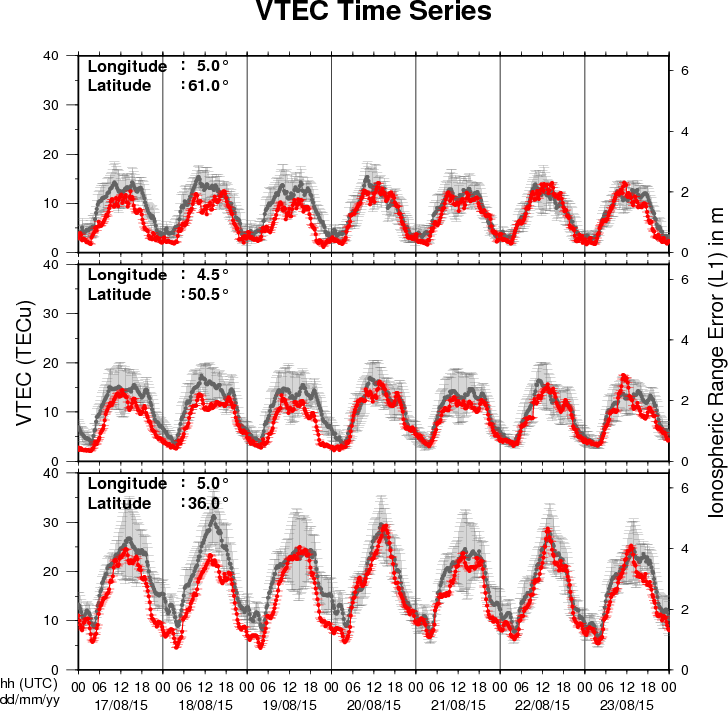
The figure shows the time evolution of the Vertical Total Electron Content (VTEC) (in red) during the last week at three locations:
a) in the northern part of Europe(N61°, 5°E)
b) above Brussels(N50.5°, 4.5°E)
c) in the southern part of Europe(N36°, 5°E)
This figure also shows (in grey) the normal ionospheric behaviour expected based on the median VTEC from the 15 previous days.
The VTEC is expressed in TECu (with TECu=10^16 electrons per square meter) and is directly related to the signal propagation delay due to the ionosphere (in figure: delay on GPS L1 frequency).
The Sun's radiation ionizes the Earth's upper atmosphere, the ionosphere, located from about 60km to 1000km above the Earth's surface.The ionization process in the ionosphere produces ions and free electrons. These electrons perturb the propagation of the GNSS (Global Navigation Satellite System) signals by inducing a so-called ionospheric delay.
See http://stce.be/newsletter/GNSS_final.pdf for some more explanations ; for detailed information, see http://gnss.be/ionosphere_tutorial.php
Start : 2015-10-26 - End : 2015-10-29
Erupting prominences/filaments, surges, flares, and coronal mass
ejections (CMEs) are prominent examples of the dynamic Sun.
Multi-wavelength and multi-instrument observations have the
potential to reveal highly energetic physical processes on the Sun
reaching from the photosphere, over the chromosphere and the
transition region, to the corona and beyond. Solar physicists have
nowadays access to a suite of new ground-based observing facilities
including, for example, the 1.5-meter GREGOR solar telescope at the
Observatorio del Teide, Tenerife, Spain, the European Low Frequency
Array (LOFAR), the Atacama Large Millimeter/Submillimeter Array
(ALMA) in Chile, and the Coronal Multi-Channel Polarimeter for
Slovakia (COMP-S) at Lomnicky Peak Observatory. A powerful fleet of
space missions, for example, the Reuven Ramaty High Energy Solar
Spectroscopic Imager (RHESSI), the Japanese Hinode, and the Solar
Dynamics Observatory (SDO), adds more capabilities to investigate
magnetic fields, complex plasma flows, and accelerated particle,
and thermal properties of solar eruptive events. In the tradition
of the series of »Potsdam Thinkshops«, we
invite instrument specialists, observers, modellers, and theorists
to exchange ideas, to stimulate discussion, to initiate future
collaborations among participants, and to attract new users of
instruments by showcasing the capabilities. The aim is to make
progress towards a comprehensive description of solar eruptive
events effectively aggregating their global properties as well as
their highly dynamic fine structure. Thinkshop 12 takes place at
the science park »Albert Einstein«, home to
AIP's Great Refractor and the Solar Observatory Einstein Tower at
the Telegraphenberg.
Website:
https://thinkshop.aip.de/12/cms/
Start : 2015-10-26 - End : 2015-10-29
The IRIS-5 workshop will be conducted at the Inter-University
Centre for Astronomy and Astrophysics (IUCAA), Pune, India from
October 26-29, 2015. This workshop is mainly aimed at the
participants who could not attend IRIS-4, which is being held at
Boulder, USA. Therefore, set up of the IRIS-5 workshop would be
essentially be very similar to that of IRIS-4.
The main aim of the workshop is to introduce the Interface
Region Imaging Spectrometer (IRIS) to students and young post docs.
This would be done through tutorials on IRIS data analysis, physics
of optically thick radiative transfer, MHD simulations of the solar
atmosphere related to IRIS and hydrodynamic simulations of flares.
There will be lectures as well as hands on sessions.
Website:
http://www.iucaa.ernet.in/~solar/Welcome.html
Start : 2015-11-09 - End : 2015-11-11
The fundamentally most important source of inner heliospheric
plasma physics and space weather is the active Sun, its solar
active region eruptions. Prediction of the evolution and influence
of solar active regions on solar storms in the near-Earth
environment is of particular interest to several forecasting
institutions, industrial stakeholders, and the public in
general.
State-of-the-art solar storm prediction tools are limited to
monitoring solar active regions, registering eruptions and mass
ejections while attempting, then, at extrapolating subsequent
evolution and spatio-temporal propagation: no realistic
physics-based and data-driven synthesis tool exists, which is
capable of predicting when a solar flare will be triggered, or when
a Coronal Mass Ejection will be launched into inter-planetary
space. In short, we are not yet able to answer the question: When
and why do solar storms launch?
Our meeting will be focused around initiation of space weather
events at the Sun. We will discuss and develop three major
challenges, and we aim to develop a draft resolution road-map for
those challenges during the meeting.
Website:
https://indico.nbi.ku.dk/conferenceDisplay.py?confId=817
Start : 2015-11-13 - End : 2015-11-13
With the launch of NASA's Solar Dynamics Observatory (SDO)
mission on 02/11/2010, researchers in solar physics have entered
the era of Big Data. The Atmospheric Imaging Assembly (AIA)
instrument on SDO provides imaging data and the Helioseismic and
Magnetic Imager (HMI) instrument on SDO provides magnetic field
data. Both instruments record data at a high spatial resolution and
a time cadence, amounting to about 1 Petabyte of scientific data
each year. The Big Data challenges in Solar Astronomy are expected
to grow even further with the inauguration of the NSF funded Daniel
K. Inouye Solar Telescope (DKIST), currently under construction in
Hawaii. This telescope is expected to generate: 3-5 Petabytes of
data per year.
Start : 2016-06-27 - End : 2016-07-01
Website:
http://www.issibern.ch/program/workshops.html
Application for the annual prize Science Communication awarded by the Koninklijke Vlaamse Academie van België voor Wetenschappen en Kunsten.
http://www.spaceweather.eu/en/repository/show?id=585
Report on the eHEROES deliverable 'Hitchhikers' guide to space'.
http://www.spaceweather.eu/en/repository/show?id=586
Report on the first period of the FP7 project eHEROES
http://www.spaceweather.eu/en/repository/show?id=587
Report of the second and final period of the FP7 project eHEROES
http://www.spaceweather.eu/en/repository/show?id=588
Report on the eHEROES deliverable 'The Space Weather News'.
http://www.spaceweather.eu/en/repository/show?id=589
Report on the FP7 project eHEROES deliverable Information and Education
http://www.spaceweather.eu/en/repository/show?id=590
Report on the FP7 project eHEROES summer school
http://www.spaceweather.eu/en/repository/show?id=591